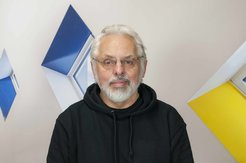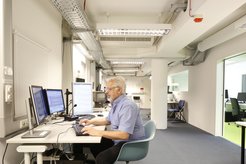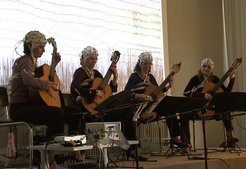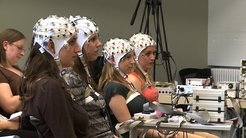Inter-Brain Synchronization: "My fascination with the topic continues to this day!"
Interview with Viktor Müller on the occasion of his retirement
During collaborative music-making, kissing, or playing chess, the brains of those involved connect, and their brain waves synchronize. Biologist Viktor Müller co-discovered the phenomenon of so-called inter-brain synchronization and dedicated almost his entire career to its exploration. After 20 years as the head of the 'Interactive Brains, Social Minds' project at the Center for Lifespan Psychology, he is now retiring. In this interview, he shares insights into his research, its most significant findings, and why he would always choose this fascinating research topic again.
You have been working at the Center for Lifespan Psychology for about 20 years. What motivated you to stay for such a long time?

Viktor Müller: As a biologist, I have always been intrigued by questions in lifespan psychology, especially those related to aging. What I find particularly fascinating is investigating these phenomena at the level of neural and physiological processes, especially using methods like electroencephalography (EEG) and other electrophysiological techniques that reveal what's happening in the brain and how it changes over time. The subject is quite complex, but that's precisely what makes it so exciting for me. I'm captivated by how neural networks form and how they can help us better understand our thinking processes and cognitive abilities. It gets even more thrilling when considering multiple brains and their synchronization, giving rise to interconnected networks.
Additionally, my role as the head of the EEG laboratory was very important to me. I've been involved since the beginning, contributing to the technical and organizational setup of the lab with my colleagues. This has motivated me to stay at the institute for an extended period.
You were the head of the project 'Interactive Brains, Social Minds.' Could you provide us with more details about this project?
Viktor Müller: The 'Interactive Brains, Social Minds' project was initiated during my time in Saarbrücken in collaboration with Ulman Lindenberger. We aimed to find out how musicians, playing as an ensemble, are able to coordinate their actions with astonishing precision, down to just a few milliseconds. A central hypothesis, proposed by Ulman Lindenberger and driving our research, suggested that such precise coordination requires a corresponding synchronization of the musicians' brains – a phenomenon later coined as 'inter-brain synchronization.' We introduced this term for the first time in our groundbreaking article on guitarists (Lindenberger et al., 2009), and it has since become a key concept in the scientific community.
Our goal was to explore the behavioral and brain mechanisms enabling individuals to synchronize their actions, especially during collaborative music-making or in activities like dance or acrobatics, temporally and spatially. By delving into the study of inter-brain synchronization, we gained profound insights into the neurobiological processes that underlie such precise and coordinated interactions.
What notable findings did you uncover, and were there any outcomes that took you by surprise?

Viktor Müller: Our research on inter-brain synchronization has revealed that this phenomenon occurs not only during music-making but also in various other social situations – for example, during kissing, computer and chess games, collaborative decision-making, and interactive perception. In one study (Müller et al., 2021), we even found that the strength of this synchronization can be used as feedback for participants. When we visually show them how well their brains are synchronized – for example, through moving balls or pendulums swinging side by side – participants can actually learn to better align their brains. This could be particularly useful in helping individuals establish better social connections through improved inter-brain synchronization, especially for those facing difficulties, such as autistic children or individuals with limited social skills.
In a collaborative study with a team led by Professor Jörg Fachner from Anglia Ruskin University on music therapy, we have, for example, demonstrated that the inter-brain synchronization between the therapist and a person with dementia increases during specific moments in the therapy session, which may be crucial for the therapy, with an anticipation of the therapist's neural activity (Maidhof et al., 2023).
In our studies, we discovered 'hyper-brain modules.' These are specific areas in two or more brains that join forces and work in synchronized fashion during an interaction. Through a specialized analysis, we could identify these modules and determine that they can play a crucial role. In a study on kissing (Müller & Lindenberger, 2014), we found that there are inter-brain networks utilizing different frequencies interactively. These networks were linked to satisfaction during kissing and the quality of the kiss. In other words, specific parts of these brain networks influenced the individuals' feelings during the kiss.
Building on the identification of hyper-brain modules, you suggest a hyper-brain cell assembly hypothesis. Could you explain this concept?
Viktor Müller: As explained earlier, synchronization within and between brains, leads to a hyper-brain network. The hyper-brain cell assembly hypothesis I formulated is rooted in Donald Hebb's theory of cell assemblies, as outlined in his renowned 1949 book, The Organization of Behavior. Hebb posited that cortical neurons strengthen their connections when they are repeatedly active simultaneously, and that this synaptic reinforcement through repeated co-activation plays a significant functional role.
Hebbian cell assemblies are like teams of brain cells that connect when they frequently collaborate. A few active cells can activate the entire team. My idea is that such teams can emerge not only within individual brains but also throughout the entire hyper-brain network – I call these hyper-brain cell assemblies. When specific synchronization patterns associated with social situations emerge, they activate entire hyper-brain cell assemblies previously formed in similar situations. This helps enhance our interpersonal behavior, allowing us, for instance, to play music with others or engage in sports together. In our studies, we found hyper-brain modules across brains that indicate strong connections between brains. These hyper-brain modules serve as prototypes for the proposed hyper-brain cell assemblies (Müller, 2022).
Why did you specifically focus on the action coordination of musicians?
Viktor Müller: The starting point of our project was the investigation of the action coordination of musicians, which proved to be an excellent model for exploring social interactions. Recent research has shown that not only the brains of musicians are in sync, but also the brains with the sounds of the instruments. The sound of an instrument is produced by the behavior of the musician, continually adapting sensorially and motorically. Simultaneously, the sound influences the musician's behavior through auditory channels, becoming an active part of the performance. Our work (Müller & Lindenberger, 2019) suggests that understanding music improvisation and interaction depends on appropriately considering these interactions between the musician and sound.
Additionally, we conducted a study with the MPIB Choir that resulted in various publications (Müller & Lindenberger, 2011; Müller, Delius, & Lindenberger, 2018, 2019; Delius & Müller, 2023). Here, we found that not only are brains synchronized during social interaction, but also other systems of our bodies, such as breathing, heart, and voice, are synchronized among themselves. This led us to the concept of a 'superorganism,' illustrating that during choir singing, various parts and systems of our bodies collaborate like a single organism.
In a collaborative study with a team led by Professor Melanie Wald-Fuhrmann from the Max Planck Institute for Empirical Aesthetics in Frankfurt, we were also able to show that the systems of the superorganism 'choir' communicate even more strongly with each other when sung with physical contact among the singers, practically in the tradition of early Christian sacred music (Lange et al., 2022).
Is there a special moment in your career that you like to return to? Something that you particularly remember?

Viktor Müller: There are two moments in my scientific career that gave me particular pleasure. One of them was our Lab Concert Study, including our kissing study. In this study, we simultaneously examined the brain activity of quartet of guitarists and four audience members during a live concert at the institute using EEG measurements. Conducting EEG measurements on eight individuals simultaneously was a real challenge, but the results of this study, recently reported in a paper (Müller & Lindenberger, 2023), provided valuable insights.

I also enjoy reminiscing about the ZDF shoot for the Terra X program. Our studies on the guitar quartet were reenacted and filmed. For this production, we even collaborated with a quintet of guitarists and utilized high-speed cameras to present the research in a new way to a broader audience. It was a fantastic experience to make our work accessible to everyone in this manner and to employ innovative cinematic methods.
How do you believe the institute has changed over time? Are there developments that have particularly impressed you?
Viktor Müller: Since I started at the institute in 2004, there have been notable changes. Initially, the research primarily focused on behavioral studies. However, the establishment of the EEG laboratory marked a significant leap forward. Furthermore, the acquisition of an independent MRI scanner and the establishment of corresponding labs in Dillenburger Straße ultimately led to the creation of the Max Planck Dahlem Campus for Cognition (MPDCC).
These developments have strongly influenced the scientific orientation and work of the institute. I am particularly pleased to have witnessed and contributed to these advancements during my time at the institute.
What does the future hold for your research? Will the project continue?
Viktor Müller: The 'Interactive Brains, Social Minds' project officially concludes with my retirement. However, research within the project will continue. The data from the extensive studies already conducted will be further analyzed and published. I am confident that many interesting and surprising insights are yet to be uncovered in the data collected over the years. Even though I am retiring, I will remain at the institute and support the continuation of this work. I am particularly eager to see what will emerge from these extensive datasets.
If you were at the beginning of your career today, what research question would you address?
Viktor Müller: Throughout my scientific career in Tübingen, Saarbrücken, and Berlin, I delved into various topics, ranging from perception from a psychophysical perspective to cognitive behavioral therapy and to the effects of smoking on the body, cell volume regulation, and its magnetoencephalographic correlates in different studies. However, what fascinated me the most were synchronization phenomena, particularly in the context of inter-brain synchronization, and this fascination still persists today. If I were to embark on my scientific journey anew, I would once again choose to explore synchronization phenomena. This research question is intertwined with other aspects that equally intrigue me, such as neural networks, complexity and chaos theory, and nonlinear dynamics. However, synchronization is crucial and forms the essential core of my research interests.
Would you share your plans for your retirement with us? Are there specific projects or activities that you are particularly looking forward to?
Viktor Müller: In retirement, my main plan is to travel more and explore beautiful places both in Germany and internationally. I am excited to finally have more time for reading novels and other books, something I couldn't dedicate enough attention to during my active years. I am particularly interested in philosophical writings and art.
Apart from these intellectual activities, I also want to enjoy the simple pleasures of life: long walks in nature, discovering new culinary delights, and spending more time with family and friends. Retirement allows me to focus on what truly matters to me. I am curious to see how these new activities and interests will reshape my perspective on life.
About Viktor Müller:
Viktor Müller has over 30 years of experience in electrophysiology and neuroscience, with a focus on investigating changes in neuronal and behavior-related mechanisms across the lifespan and in social interactions. In 1995, he earned his Ph.D. in Psychology/Social Sciences from the University of Tübingen. From 1993 to 2000, he worked as a research associate at the Institute of Medical Psychology and Behavioural Neurobiology at the University of Tübingen, where he received the “Nordmark Neuropharmaka Preis” for research on cognitive behavioural therapy for Parkinson's patients.
From 2000 to 2002, he participated in a collaborative project between the MEG Center and the Institute of Physiology at the University of Tübingen, investigating the effects of drinking water on cortical excitability in humans using MEG (magnetoencephalography). From 2002 to 2004, he joined the Department of Psychology at Saarland University, collaborating with Ulman Lindenberger on differences in electrocortical activity across the lifespan using EEG (electroencephalography).
In 2004, he moved to Berlin and established the EEG Laboratory at the Center for Lifespan Psychology at the Max Planck Institute for Human Development. Until his retirement, he served as the head of the EEG Laboratory and led the project 'Interactive Brains, Social Minds.'
Selected publications
You can find all of Viktor Müller's publications here.





